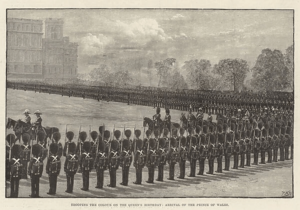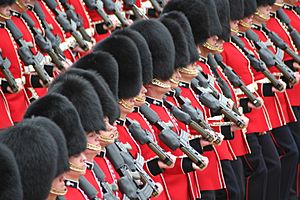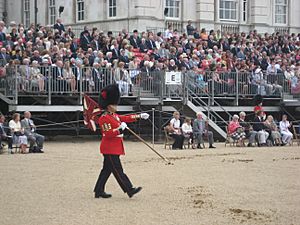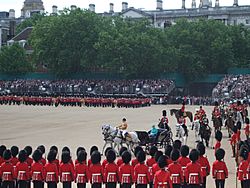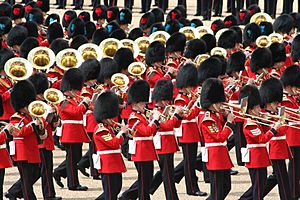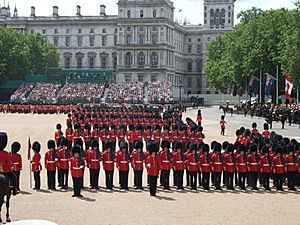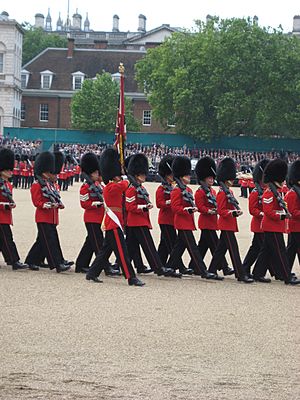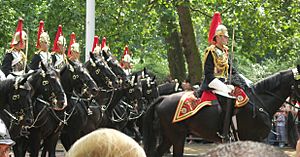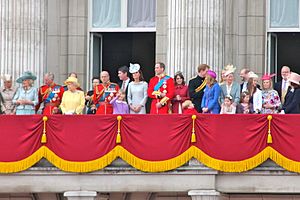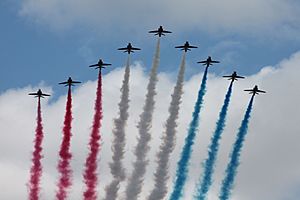Trooping the Colour facts for kids
Trooping the Colour is a special event held every year in London, United Kingdom. It takes place on Horse Guards Parade and involves soldiers from the Household Division. This ceremony celebrates the official birthday of the British King, even if it's not his actual birth date. It's also known as the Sovereign's Birthday Parade. Similar events happen in other countries that are part of the the Commonwealth. In the UK, it's one of the biggest royal events, watched by millions on TV and by crowds in London.
Long ago, special flags called colours were used in battles to help soldiers find their way and stay together. These flags show a regiment's brave history and are very important in the Trooping the Colour ceremony. This tradition has marked the King's official birthday since 1748. Each year, one of the five Foot Guards regiments is chosen. They slowly carry their special flag, called a "colour," through lines of other guards. As the flag passes, the soldiers salute it, and the King salutes it back.
During the ceremony, the King travels from Buckingham Palace to Horse Guards Parade in a royal parade. He is escorted by the Household Cavalry, who are soldiers on horseback. After a royal salute, the King inspects his soldiers. About 400 musicians, including bands from the Foot Guards and Household Cavalry, play music. Once the colour is brought out, it leads the march past the King. The Foot Guards march, while the mounted troops (on horses) walk and trot past.
After the parade, the King returns to Buckingham Palace. He watches another march-past from outside the palace gates. Then, the royal family appears on the palace balcony. They watch a Royal Air Force flypast, which is a display of planes flying overhead. A 41-gun salute is also fired in Green Park.
Contents
- The King's Official Birthday Celebration
- Who Participates and How the Parade Works
- Parade Steps and Movements
- Starting the Parade
- The King Arrives
- Inspecting the Soldiers
- The Bands March
- Getting the Colour (Flag) Ready
- Getting Ready to Troop the Colour
- Trooping the Colour Through the Ranks
- Getting Ready for the March-Past
- Foot Guards March Past
- Mounted Troops Ride Past
- Getting Ready to March Off
- Marching Off
- After the Ceremony
- Regimental Marches of the Foot Guards
- Regiments Trooping Their Colour (Recent Years)
- Practice Parades
- Trooping the Colour in Other Countries
- Trooping the Colour in Jordan
- Images for kids
- See also
The King's Official Birthday Celebration
Why the King Has an Official Birthday Parade
In the United Kingdom, Trooping the Colour is also called the "King's Birthday Parade." It was first performed during the time of King Charles II (1660–1685). In 1748, it was decided that this parade would mark the King's official birthday. By 1760, after George III became King, it became an annual event.
Queen Victoria only attended Trooping the Colour once, in 1895, at Windsor Castle. While some parts of the parade have stayed the same, the full ceremony we see today was set in 1889.
When the King's Official Birthday Happens
King Edward VII had his actual birthday in November, which can be cold and rainy in Britain. So, he decided to hold his official birthday celebration in May or June for better weather. This tradition continues today. The event usually takes place at Horse Guards Parade near St James's Park, London. It happens around the same time as the Birthday Honours List is announced, which recognizes people for their achievements.
After the parade, a 41-gun salute is fired at noon in Green Park. Then, the royal family watches a flypast of planes over Buckingham Palace from the balcony.
Since 1959, the parade has usually been held on a Saturday in June. For example, in 2018 it was on June 9th, and in 2019 on June 8th. In 2020 and 2021, a smaller version of the ceremony happened at Windsor Castle because of the COVID-19 pandemic.
In 2022, Trooping the Colour was held on a Thursday, June 2nd. This date was special because it was the anniversary of Queen Elizabeth II's coronation in 1953.
In 2023, Charles III had his first birthday parade as King on June 17th.
Watching the Parade on TV
Trooping the Colour was first broadcast on BBC Radio in 1927. It was first shown on BBC Television in 1937.
Millions of people around the world watch the parade on TV. In 1961, the parade was even shown in the Soviet Union. Famous commentators like Richard Dimbleby and Huw Edwards have described the event for the BBC in the UK. Now, you can also watch it live online on platforms like YouTube.
The King's Role in the Parade
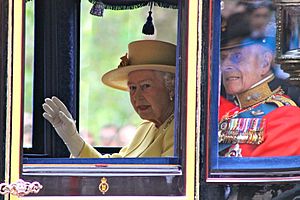
Queen Elizabeth II attended Trooping the Colour every year of her reign, except in 1955 when it was canceled due to a train strike. From 1969 to 1986, the Queen rode her horse, Burmese, in the parade. After 1987, she rode in a carriage.
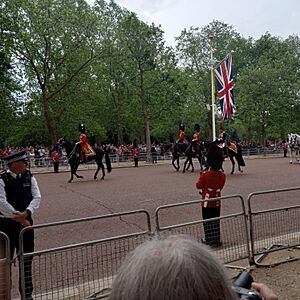
For her 80th birthday in 2006, 40 planes flew over, led by the Battle of Britain Memorial Flight. This was followed by a "feu de joie" (a special celebratory firing of guns). In 2008, 55 aircraft flew past to celebrate the RAF's 90th anniversary.
In 2023, King Charles III brought back the tradition of the King riding on horseback and in uniform for his first Trooping the Colour as monarch. A flypast of about 70 aircraft, originally planned for his coronation, also took place.
Who Participates and How the Parade Works
On the day of Trooping the Colour, the Royal Standard flag flies from Buckingham Palace and the Horse Guards Building.
Foot Guards and the Escort for the Colour
Six companies of Foot Guards stand in an "L" shape around the edge of Horse Guards Parade. This formation reminds people of an old battle strategy called a "hollow square."
The company chosen to "troop" its colour that year is called No. 1 Guard. They are first known as 'Escort FOR the Colour'. Later, after they collect their flag, they become 'Escort TO the Colour'. The special flag is initially held by a small group of soldiers called the Colour Party. Once the flag is collected, an Ensign (a junior officer) from No. 1 Guard carries it through the lines of the other guards.
Mounted Troops and the King's Escort
Soldiers on horseback, including the King's Troop, Royal Horse Artillery and the Household Cavalry Mounted Regiment (the Life Guards and the Blues and Royals), line the edge of St. James's Park.
In the Royal Procession, the Household Cavalry are called the "Sovereign's Escort." They ride in front of and behind the King. The Life Guards and the Blues and Royals take turns leading these positions each year.
Parade Leaders
Three officers on horseback from No. 1 Guard give commands during the parade. The most senior is the Field Officer in Brigade Waiting. He is helped by the Major of the Parade and the Adjutant.
The Garrison Sergeant Major of London District, who is on foot, makes sure the whole event runs smoothly on the parade ground and the road from the Mall.
Military Bands and Music
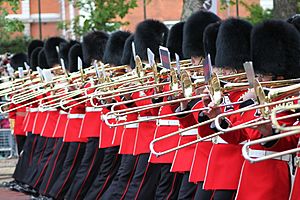
Almost 400 musicians are on the field, led by the Massed Bands of the Household Division. The Foot Guards' bands alone have over 200 musicians. Since 2014, the Mounted Band of the Household Cavalry also joins them. All these musicians are part of the Royal Corps of Army Music. There are also Corps of Drums and sometimes pipe bands from the Scots Guards and Irish Guards. The Corps of Drums and Pipe Bands usually march behind the main bands.
How the Parade Unfolds
The entire parade involves several parts, performed in both slow and quick march times. The "Trooping the Colour" part is the main event.
- The King first inspects the Foot Guards, then the Household Cavalry and King's Troop. Different music is played for each.
- Next, the massed bands "troop" (march) before the King. A single drummer then breaks away and marches to No. 1 Guard.
- The drummer plays a special signal called "Drummer's Call." This tells No. 1 Guard, the Escort for the Colour, to march to the center of the field and get their flag from the Colour Party. The massed bands perform a special turning move called the "Spin Wheel."
- Now called the "Escort to the Colour," No. 1 Guard slowly carries its regimental flag through the lines of the other guards.
- After forming up, all six Foot Guards companies march past the King in slow and quick time.
- The King's Troop and Household Cavalry then ride past the King, first walking and then trotting. The mounted band salutes the King as they leave.
- Finally, led by the King's Escort, the massed bands play as the King returns to Buckingham Palace. The Foot Guards follow, and the King's Troop heads to Green Park.
Parade Steps and Movements
The whole parade is overseen by the Field Officer in Brigade Waiting, helped by other officers on horseback. The London District Garrison Sergeant Major, on foot, coordinates everything.
Starting the Parade
First, soldiers carrying marker flags march on to show where each of the six Foot Guards companies will stand. These flags are the company colours from each regiment.
Then, the six Foot Guards companies march into their positions, led by their regimental bands. No. 1 Guard is the "Escort for the Colour."
- Nos. 1-5 Guards line up on one side of the parade ground, facing the Horse Guards Building.
- No. 6 Guard lines up at a right angle to them, forming an "L" shape.
- The massed bands are on the south side, near the gardens of 10 Downing Street.
- The Colour Party, made up of three soldiers, stands near No. 6 Guard. A drummer joins them, and the colour's cover is removed, showing the flag.
- The King's Troop, Household Cavalry, and their mounted band line up behind the Foot Guards.
The soldiers' colorful uniforms make for a grand sight. Other guards line the road to Horse Guards Parade to keep the area safe for the Royal Family and the marching troops.
The King Arrives

Before the King, other senior members of the royal family arrive in special carriages called barouches. They watch the ceremony from a window in the Duke of Wellington's old office in the Horse Guards Building.
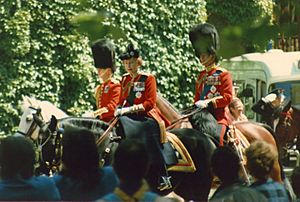
The King, who is the Colonel-in-Chief of the regiments, rides from Buckingham Palace down the Mall on horseback. Behind him ride other Royal Colonels, like William, Prince of Wales and Anne, Princess Royal. Queen Camilla and Catherine, Princess of Wales ride in a carriage behind them. As the King passes the flag that will be trooped, he salutes it.
When the King arrives, the Royal Standard flag is raised on the roof of the Horse Guards building. The King then gets off his horse at the Saluting Base to begin the ceremony.
The Field Officer starts the parade by commanding, "Guards – Royal Salute – Present Arms!" The national anthem (God Save The King) is played by the Massed Bands. At the same time, the Royal Standard is officially raised.
Inspecting the Soldiers
The King then rides along the long line of soldiers, inspecting them. The Royal Colonels follow him. TV commentators often mention how well the King knows his guards and how important "steadiness" is for a guardsman.
The music played during the inspection often includes a traditional march from the regiment whose colour is being trooped. For example, if the Welsh Guards are trooping their colour, you might hear "Men of Harlech." The King rides past the Foot Guards while a slow march is played. When he turns around, the music changes to a quick march as he passes the Household Cavalry and King's Troop. After the inspection, the music stops, and the King returns to the saluting base.
The Bands March
Once the King is back at the saluting base, the Field Officer gives the command "Troop!" This is for the bands to start their march. The Massed Bands march and countermarch (march back and forth) on Horse Guards Parade. A lone drummer from the Corps of Drums breaks away and marches to No. 1 Guard.
The drummer plays a special eight-bar tune called "Drummer's Call." This signals the Captain of No. 1 Guard to let his junior officer take command. The lone drummer then returns to the Massed Bands.
Getting the Colour (Flag) Ready
No. 1 Guard, now called "Escort for the Colour," performs the central part of the parade.
The Regimental Sergeant-Major (RSM) draws his sword, which is a rare sight for an infantry officer on parade. The Escort for the Colour marches to the Colour Party to get the flag. They march to the tune "The British Grenadiers." This tune is always used, no matter which regiment's colour is being trooped. The music stops, and the Escort halts.
The RSM marches to the Colour Party and takes the flag from the Colour Sergeant. He then presents the flag to the Ensign, who takes it.
Now that No. 1 Guard has their flag, they are called "Escort to the Colour." The massed bands are now ready, facing forward.
Getting Ready to Troop the Colour
The Escort to the Colour salutes as the first six bars of "God Save the King" are played. Soldiers at the corners of the Escort hold their rifles in a special way to "protect" the flag.
The Escort to the Colour then prepares to march slowly. The Massed Bands turn around.
The Bands' Spinwheel Move
As the Escort to the Colour slowly marches towards No. 6 Guard, the massed bands perform a unique anti-clockwise "spinwheel" maneuver. This is a 90-degree turn in a small space, done while playing the slow march "Escort to the Colour."
This "spinwheel" is very complex. The musicians have to adjust their steps, some marching long distances quickly, while others move slowly or even backward. It's like an art form, and each time it's performed, it's slightly different.
Once the Escort reaches No. 6 Guard, the music stops. The Field Officer orders everyone to salute as the actual "trooping" begins. The music changes to "The Grenadiers' Slow March."
Trooping the Colour Through the Ranks
To the music of "The Grenadiers Slow March," the Escort to the Colour carries the flag down the long line of Guards Nos. 6-2. The Ensign carries the flag in front of the line of guards. The other guards remain in the 'present arms' position, which requires a lot of strength, especially on a hot day. As this happens, the Massed Bands move back to their original places.
Eventually, the Escort returns to its starting position as No. 1 Guard. The Field Officer then orders the entire parade to lower their arms, ending the trooping phase.
After this, the Foot Guards march past in slow and quick time. Then, the Household Cavalry and King's Troop also ride past in slow and quick time.
Getting Ready for the March-Past
The Field Officer gives the command, "Officers, take post." The Foot Guards then turn and form into their review formation. The Adjutant gives a signal for the company guides to return to their positions. The Foot Guards turn again as the Corps of Drums plays.
Once everyone is in place, the Field Officer salutes the King and tells him the Foot Guards are ready to march past. He then commands, "Guards will march past in slow and quick time... Slow march!"
Foot Guards March Past
No. 1 Guard, the Escort, leads the six companies for two circuits around Horse Guards Parade. They salute the King as they pass. The corners of the field are turned using a complex "Left Form" maneuver.
At the end of both the slow and quick march-past, the Field Officer rides out to salute the King, telling him that his Guards have finished their march-past.
Slow March-Past
The Massed Bands march to the center of the field. The Field Officer and Major of the Parade lead the guards past the King, saluting him with their swords.
To the tunes of their regimental slow marches, each of the six Foot Guards companies passes before the King. Their officers salute with swords. No. 1 Guard, the Escort to the Colour, has a special honor: the Ensign lowers the flag in a "flourish." The King bows his head, and the Royal Colonels salute the flag. Once past the King, the flag is raised again.
The King and Royal Colonels acknowledge each company's salute.
Quick March-Past
For this part, the flag is at the back of the Escort (No. 1 Guard), protected by the Colour Party. Each guard passes before the King to the tune of their regimental quick marches. The officers do not salute with swords during the quick march, only with their eyes. The flag is marched past the King, Queen, and Royal Colonels, who salute it.
The massed bands then move away to allow the mounted bands onto the ground. The Foot Guards finish their march and return to their positions.
Mounted Troops Ride Past
The Mounted Band of the Household Cavalry, led by two drum horses, rides slowly onto the field.
Now it's the turn of the Household Cavalry and King's Troop to complete two circuits of Horse Guards Parade. For the horses, "slow time" means a walk, and "quick time" means a trot. Since 1997, the mounted group is led by the commander of the King's Troop, then by the Sovereign's Escort commander.
During both parts of the ride past, the Foot Guards salute as ordered by the Field Officer.
Walk-March
Salutes are given to the King, and he, the Queen, and the Royal Colonels return them as the flags pass.
The Royal Horse Artillery, with their guns, goes first. When the King's Troop passes, the King acknowledges the leading gun as if it were a flag.
The Life Guards, in red jackets, are next, followed by The Blues and Royals, in blue jackets. Officers salute with their swords during this part.
At the back of the Household Cavalry are the farriers, one for each regiment. They carry shining axes.
The two Household Cavalry regiments take turns parading. The King's Cavalry Standard (flag) is dipped as it passes the King, Queen, and Royal Colonels.
Trot-Past
A special trumpeter plays "The Trot" to signal the start of the trot-past. The tune "The Keel Row" is traditionally played, and the horses kick up a lot of dust. Both the King's Troop's lead gun and the King's Cavalry Standard (not dipped) trot past the King and Royal Colonels, who are saluted.
As the trot-past ends, the mounted band salutes the King. They then move back to the east side of Horse Guards Parade and stop.
Getting Ready to March Off

The director of music signals the Field Officer that the Household Cavalry and King's Troop are ready to end the parade.
During the final Royal Salute, as all seven regiments of the Household Division wish the King a happy birthday, the flag of No. 1 Guard is lowered to the ground. "God Save the King" is played by the Massed Bands. The guards then get ready to march off, and the Household Cavalry and King's Troop leave the field. The Field Officer tells the King that the guards are ready to march off.
The King's Troop, Royal Horse Artillery, leaves Horse Guards Parade and goes to Green Park to fire a 41-gun salute. At the same time, the Honourable Artillery Company (HAC) gets ready at the Tower of London for a special 62-gun salute, which only happens on royal anniversaries.
Marching Off
Led by the massed bands, the King places himself at the front of his Foot Guards. The entire parade, with 1,000 soldiers and 400 musicians, marches up the Mall towards Buckingham Palace. The King's Troop and the HAC are ready to fire their salutes as the Royal Family arrives at the palace.
After the Ceremony
When the King returns to Buckingham Palace, part of the Escort to the Colour enters the palace forecourt. The rest of the guards march past outside the gates in quick time, saluting the King. The King watches from the central gateway. The rest of the royal family watches from the balcony.
The King enters the palace between the Old and New Guards, who both salute him and the Royal Colonels. The daily Changing of the Guard continues in the palace forecourt.
The gun salutes begin when the King arrives at Buckingham Palace. The King's Troop fires a 41-gun salute in Green Park, and the Honourable Artillery Company fires a 62-gun salute from the Tower of London.
Finally, the King and the royal family on the palace balcony watch a flypast by the Royal Air Force. This often includes planes from the Battle of Britain Memorial Flight and the Red Arrows. The National Anthem is played again, and in special years, a "feu de joie" is fired, followed by three cheers for the King.
Regimental Marches of the Foot Guards
Here are links to the words and music of the regimental marches of the five Foot Guards regiments.
Slow Marches
- Grenadier Guards: "The March from Scipio", composed by Handel.
- Coldstream Guards: "Figaro" (the tune is "Non piu andrai" from Mozart's Le nozze di Figaro).
- Scots Guards: "The Garb of Old Gaul" Lyrics and Music.
- Irish Guards: "Let Erin Remember" Lyrics and Music.
- Welsh Guards: "Men of Harlech" Lyrics and Music.
Quick Marches Music for all five regiments' quick marches
- Grenadier Guards: "The British Grenadiers" Lyrics and melody-notation and Music.
- Coldstream Guards: "Milanollo." This march was composed for two young violin players.
- Scots Guards: "Hielan' Laddie" (Listen).
- Irish Guards: "Saint Patrick's Day" (Listen).
- Welsh Guards: "The Rising of the Lark" (Listen) Lyrics and Music.
Regiments Trooping Their Colour (Recent Years)
Since only one flag can be "trooped" at a time, each year one battalion from the five Foot Guards regiments is chosen.
| Year | Battalion | Regiment | Colonel | Notes |
|---|---|---|---|---|
| 2001 | 2nd Battalion | Grenadier Guards | Prince Philip, Duke of Edinburgh | It rained heavily. This was the 50th anniversary of Elizabeth's first Trooping for her father, King George VI. |
| 2002 | 1st Battalion | Scots Guards | Prince Edward, Duke of Kent | Part of Queen Elizabeth II's Golden Jubilee celebrations. |
| 2003 | 1st Battalion | Grenadier Guards | Prince Philip, Duke of Edinburgh | |
| 2004 | 1st Battalion | Grenadier Guards | Prince Philip, Duke of Edinburgh | Inkerman Company trooped the colour. |
| 2005 | 1st Battalion | Irish Guards | James Hamilton, 5th Duke of Abercorn | |
| 2006 | 1st Battalion | Welsh Guards | Charles, Prince of Wales | |
| 2007 | 2nd Battalion | Coldstream Guards | Sir Hugh Rose | The 1st Battalion was supposed to troop but was on duty elsewhere. |
| 2008 | 1st Battalion | Welsh Guards | Charles, Prince of Wales | |
| 2009 | 1st Battalion | Irish Guards | Sir Sebastian Roberts | This was the first time seven Foot Guards companies took part since 1993. |
| 2010 | 1st Battalion | Grenadier Guards | Prince Philip, Duke of Edinburgh | |
| 2011 | 1st Battalion | Scots Guards | Prince Edward, Duke of Kent | This was the first time a battalion not based in London trooped. It was also the 60th anniversary of Elizabeth's first Trooping. |
| 2012 | 1st Battalion | Coldstream Guards | Lt Gen Sir James Bucknall | First time this battalion trooped since 1999. Part of Queen Elizabeth II's Diamond Jubilee celebrations. |
| 2013 | 1st Battalion | Welsh Guards | Charles, Prince of Wales | |
| 2014 | 2nd Battalion | Grenadier Guards | Prince Philip, Duke of Edinburgh | |
| 2015 | 1st Battalion | Welsh Guards | Charles, Prince of Wales | The parade was on Saturday, June 13th. It was also the Welsh Guards' 100th anniversary. |
| 2016 | 2nd Battalion | Coldstream Guards | Lt Gen Sir James Bucknall | The parade was on Saturday, June 11th, part of the Queen's official 90th birthday celebrations. |
| 2017 | 1st Battalion | Irish Guards | Prince William, Duke of Cambridge | The parade was on Saturday, June 17th, part of the Queen's Sapphire Jubilee celebrations. |
| 2018 | 1st Battalion | Coldstream Guards | Lt Gen Sir James Bucknall | The parade was on June 9th. The Queen was joined by the Duke of Kent. |
| 2019 | 1st Battalion | Grenadier Guards | Prince Andrew, Duke of York | The parade was on June 8th. It marked 100 years since the end of World War I and the Victory Parade of 1919. |
| 2020 | 1st Battalion | Welsh Guards | Charles, Prince of Wales | The public event was canceled due to the coronavirus pandemic. A smaller private parade was held at Windsor Castle. |
| 2021 | 2nd Battalion | Scots Guards | Prince Edward, Duke of Kent | The public event was canceled due to the coronavirus outbreak. A private televised parade was held at Windsor Castle. It marked the Queen's official 95th birthday and the 70th anniversary of her first Trooping. |
| 2022 | 1st Battalion | Irish Guards | Prince William, Duke of Cambridge | Part of Queen Elizabeth II's Platinum Jubilee celebrations. The Prince of Wales took the salute at Horse Guards, and the Queen saluted at Buckingham Palace. |
| 2023 | 1st Battalion | Welsh Guards | William, Prince of Wales | This was the first Trooping the Colour for King Charles III as monarch. He rode on horseback. All five Guards regiments participated for the first time since 1988. |
| 2024 | 2nd Battalion | Irish Guards | Catherine, Princess of Wales | This was the first time the 2nd Battalion, Irish Guards, trooped their colour. It was also the first time the Princess of Wales took the Salute as Colonel of the Irish Guards. All five Guards regiments participated. |
| 2025 | 2nd Battalion | Coldstream Guards | Lt Gen Sir James Bucknall | This was the first time the Coldstream Guards trooped their colour in front of the King. It marked the 375th Anniversary of the Coldstream Guards. |
Some battalions, like the 2nd Battalions of the Grenadier Guards, Coldstream Guards, and Scots Guards, are not fully active. They are represented in the parade by smaller groups of soldiers. In 2022, two new groups were formed for the Irish Guards.
The number of soldiers in Trooping the Colour has changed over the years. This is due to military budget cuts and soldiers being on duty overseas. However, the basic steps of the ceremony remain the same, following old battle formations. The 1988 parade was the last time all five regiments participated until 2023. In 1993, the parade was reduced from eight guards companies to six.
Practice Parades
Before the main King's Birthday Parade, the Trooping the Colour ceremony is practiced twice. These practices happen on the two Saturdays before the main event.
The Major General's Review
This practice parade happens two Saturdays before the main event. It is exactly like the King's Birthday Parade, but without soldiers lining The Mall. The salute is taken by the Major-General who commands the Household Division.
The Colonel's Review
This practice parade happens on the Saturday before the main event. The salute is taken by the Royal Colonel of the regiment whose colour is being trooped. This time, 250 Guardsmen line the route along The Mall.
Trooping the Colour in Other Countries
Australia

In Australia, the Trooping the King's Colour happens every year on the King's Birthday Holiday. It is performed by the cadets of the Royal Military College, Duntroon, in Canberra. The Queen's colour was first trooped there in 1956.
The King's representative in Australia, the Governor-General of Australia, reviews the parade. Since moving to Rod Field, the public can also attend.
Bermuda
In Hamilton, Bermuda, the Trooping of the Colour is held on Front Street. It involves soldiers from the Royal Bermuda Regiment and supporting units. The Governor of Bermuda inspects the units. At the end, the guards perform a "Feu de joie" (a celebratory firing), followed by a 21-gun salute and three cheers for the King.
Canada
In Canada, the Trooping the Colour ceremony takes place on Parliament Hill. It happens for the King, members of the royal family, the governor general, or a lieutenant-governor. It is held on Remembrance Day or for the King's Birthday on Victoria Day. New flags may also be trooped when they are presented.
The ceremony was first performed nationally in Canada in 1939. It became a regular event on Canada Day (July 1st) in 1958.
Regiments that have Trooped the Colour in Canada
- The Royal Canadian Regiment, 2002
- The Argyll and Sutherland Highlanders of Canada, Hamilton, Ontario, 2002
- Governor General's Foot Guards
- The Canadian Grenadier Guards
- The Governor General's Horse Guards
- The Canadian Guards – no longer active since 1970
- The Princess Louise Fusiliers
- The Calgary Highlanders trooped their new Queen's Colour in June 1990.
- The Grey and Simcoe Foresters, Owen Sound, Ontario, 1983
- The Toronto Scottish Regiment (Queen Elizabeth The Queen Mother's Own)
- The Lorne Scots (Peel, Dufferin and Halton Regiment), 2001, 2006, 2016
- The Black Watch (Royal Highland Regiment) of Canada, 1987, 2012
Ghana
In Ghana, the Trooping the Colour ceremony is held every year on Independence Day, March 6th. Soldiers from the Ghana Army retrieve the ceremonial flags of the Army, Navy, and Air Force, along with the Flag of Ghana. The ceremony takes place on Black Star Square. The President of Ghana, as commander-in-chief, takes the national salute. Music is played by the combined bands of the Ghana Armed Forces Central Band and school marching bands.
Regiments that take possession of the Colour of the Arab Revolt
| Year | Regiment | Notes |
|---|---|---|
| 2018 | 9th Prince Muhammad Infantry Battalion | Parade was held on Thursday, October 4th, 2018. |
| 2017 | 39th Ja'far bin Abi Talib Infantry Battalion | Parade was held on Thursday, September 28th, 2017. |
| 2016 | 28th prince Hussein bin Abdullah II Rangers Brigade | Parade was held on Thursday, June 2nd, 2016. This was the first Trooping the Colour in Jordan and the Middle East. It was part of the celebrations for the 100th anniversary of the Great Arab Revolt. |
Kenya
Kenya is one of three African countries that still performs the traditional British Trooping the Colour ceremony.
This happens every December 12th on Jamhuri Day (Kenya's independence day). Unlike the British ceremony, all three branches of the Kenya Defence Forces take part. The service branch whose battalion is trooping the colour provides the first two guards.
The ceremony usually begins after the President of Kenya arrives. He takes the national salute as the national anthem and the anthem of the East African Community are played. After his inspection, the bands play a slow march followed by a quick march. A lone drummer then plays the "drummers call," signaling officers to get ready to receive the colour. The escort marches off to collect the colour, and the massed KDF band plays. After the flag is handed over, the first verse of the Kenya national anthem is played, and the escort marches off slowly.
Malaysia
Malaysia, also part of the Commonwealth, performs Trooping the Colours every first Saturday in June. This is a few days after the official birthday of the Yang di-Pertuan Agong, the elected Malaysian king. The King, Queen, Prime Minister, and other officials attend. The King is the Commander-in-Chief of the Malaysian Armed Forces.
The Malaysian ceremony includes many parts of the British ceremony. This includes a Royal Procession, the Sovereign's Escort, a Saluting Base, a Royal Inspection, and a 21-gun salute. It is conducted in Malay and includes prayers. A key difference is that five colours are trooped, representing all three branches of the Armed Forces.
In 2014, the event was held on a Friday, June 13th, which was a change from the usual Saturday. In 2016, an old tradition returned: if the celebrations fall during Ramadan, the parade is held on the Friday before July 31st. In 2017, the Trooping the Colours was held on September 19th, after Malaysia Day. The old June date was restored in 2019.
Malta
Because of Malta's history as a former British territory, the Armed Forces of Malta performs Trooping the Colour every December 13th. This celebrates Republic Day at St. George's Square in Valletta, the capital. The President of Malta, who is the commander-in-chief, takes the salute.
The units providing the colour and band are from the 1st Regiment, Armed Forces of Malta, and the Armed Forces of Malta Band.
Singapore
The Singapore Armed Forces performs Trooping the Colours during the SAF Day Parade on July 1st. It happens on special occasions and is a simpler version compared to the British one. It takes place after State Colours are awarded to the best units of the Army, Navy, and Air Force.
The Escorts to the Colour (No.1 Guard) are usually from the Singapore Armed Forces Military Police Command. Other guards are made up of personnel from the SAF National Day Parade Guard of Honour. Unlike the British parade, there are also supporting groups that march past.
The President of Singapore, the Prime Minister of Singapore, and the Chief of Defence Force take the salute. The band is either the SAF Central Band or the SAF Ceremonial Band A.
No.2 Guard is usually from the Best Army Unit Competition winner, often the 1st Commando Battalion. Nos. 3 and 4 Guards are from the Republic of Singapore Navy and Air Force. Since 2023, No.5 Guard is provided by the HQ Digital and Intelligence Service.
Besides SAF Day, the Trooping has also been performed for unit anniversaries.
Uganda
The Ugandan Armed Forces performs a Trooping the Colour on Independence Day at Kololo Ceremonial Grounds in the capital, Kampala. The President of Uganda takes the salute.
Trooping the Colour in Jordan
Jordan held its first Trooping the Colour in June 2016. This was the first in the Middle East and celebrated 100 years since the Arab Revolt against the Ottoman Empire. The parade is officially known as the Flag Parade and is held annually in September. About 1,000 troops take part in Amman, the capital. Al Rayah Square was built specially for this event. In the parade, the King awards the Colours of the Arab Revolt to one of the army's battalions. This battalion holds the colours until the next Trooping the Colour.
In 2016, the colours went to the 28th Prince Hussein bin Abdullah II Rangers Brigade. In 2017, they were awarded to the 39th Ja'far bin Abi Talib Infantry Battalion. In 2018, the 9th Prince Mohammed Mechanised Battalion held the colours.
Images for kids
See also
 In Spanish: Trooping the Colour para niños
In Spanish: Trooping the Colour para niños



